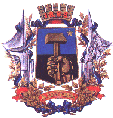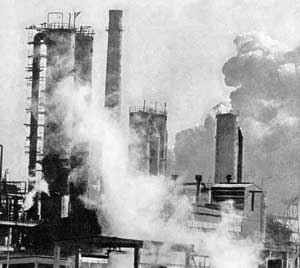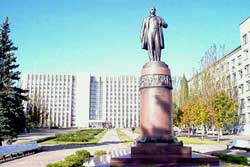

| Search the site for: |
Our City Donetsk
History of the city
 Donetsk
was founded in summer 1869, when the building of metallurgical works started
there. But to that time such villages as Aleksandrovka, Grigorevka, Semenovka
and the farm Ovechy founded by Zaporozsky kazaks were already existed
on the area of the future city. People of that villages along with farming
were involved in digging of "earth coal" or "inflammable
stone" for the local needs.
Donetsk
was founded in summer 1869, when the building of metallurgical works started
there. But to that time such villages as Aleksandrovka, Grigorevka, Semenovka
and the farm Ovechy founded by Zaporozsky kazaks were already existed
on the area of the future city. People of that villages along with farming
were involved in digging of "earth coal" or "inflammable
stone" for the local needs.
Peter the Great on his way back from the Azov crusade in 1696 found out the information about the "inflammable stone" and said fatidic words "This mineral will be useful if not for us then for our descendants".
Big lode of the coal was located at the source of the River Calmius where city is situated right now. In the beginning of last century small mines began to appear, in 1841 the first big mine Aleksandrovsy started to work.
In April 1869 the government signed The Pact about the
beginning of work on output of coal and building of the metallurgical
works.  Novorosiysk
association was created for the conducting of that work. John Huez was
appointed to be administrator of the work. Next to the platform used for
building the plant the village appeared and then joined with the area
of mining village Aleksandrovka and got the name Huzovka by the name of
administrator. On 24 of January, 1872, first blast furnace produced cast
iron. In September 1873, Huzovsky works started to operate by the full
cycle and soon took the first place in the country on the output of metal.
Novorosiysk
association was created for the conducting of that work. John Huez was
appointed to be administrator of the work. Next to the platform used for
building the plant the village appeared and then joined with the area
of mining village Aleksandrovka and got the name Huzovka by the name of
administrator. On 24 of January, 1872, first blast furnace produced cast
iron. In September 1873, Huzovsky works started to operate by the full
cycle and soon took the first place in the country on the output of metal.
In 1872 the movement by the railway Konstantinovka - Yasinovataya - Husovka - Elenovka has started and then was extended to Mariupol. This line connected plant and mines with the operative railway main of Donbass. This caused enlarging of the industry production. Engineering and iron foundry works were built. The population of Huzovka increased.
In May, 1917, when there were about 70, 000 citizens in the village, it was given the rate of the city. It was divided into two parts: South part, where industry buildings, railway station, telegraph, small hospital and school were situated and North part with living places for workers, market and pubs.
In 1924 Huzovka was renamed into Stalino. The population
of it to that moment reached 63, 708 people and in 1925 it was increased
up to 80, 085 people.
In July 1932 city became the center of Donetsk region.
In 1938 Donetsk region was divided in Voroshilovgradsky and Stalinsky. City stayed the center of Stalinsky region.
Up to 1041, 223 enterprises of Union or republican subordination and 54 local and cooperative enterprises were situated in the city.
In 1961 city got the new name Donetsk.
(the source of information is "Donetsk. Love your city."
Donetsk Today
The city of Donetsk is one of the biggest regional centers in Ukraine. It covers 381 square kilometers, with a population of about 1,131,700.
 For
a large industrial town, Donetsk is especially beautiful and very green.
It is made up of 9 districts which are linked together by tram, trolley
and bus routes. It also has well developed air and railway services.
For
a large industrial town, Donetsk is especially beautiful and very green.
It is made up of 9 districts which are linked together by tram, trolley
and bus routes. It also has well developed air and railway services.
Area:
the total area -381 square km,
the spread from North to South - 28 km, from West to East - 55 km, the
area of the parks - 216.2 hectors.
Schools:
2 Primary schools
38 Secondary schools
116 High schools
7 Sport schools
2 Stations of young mechanics
8 Palaces of youth creativity
54 Youth clubs
Colleges:
6 State colleges,
1 brunch of State college,
9 private colleges (6 of them are licensed).
Structure of City Council.
Donetsk is administrative center of Donetsk region. The representatives
of the following cities are included in City Council: Donetsk (9 rayons),
Mospino, villages like Larina, Gorbochevo-Mihaylovka and 8 countrysides.
Communications.
Total length of water supplying lines is 2, 398 km, - 1, 176 km.
Streets and squares.
Squares - 21,
Streets, boulevards, prospects - 2, 220, total length of streets is 2,
500 km.
Rivers and reservoirs.
There are 5 rivers, the longest out of them are Cherepashkina (23 km)
and Asmolovka (13 km). All rivers on the area of city flow to the River
Calmius. 2 reservoirs are Donetsk sea (206 hectares) and Calmius reservoir
(60 hectares).
Twin-cities.
Sheffield (UK), Bohum (Germany), Sharlerua (Belgium), Toronto (Italy).
Please see business opportunity for Donetsk in BISNIS report.
| Links | e-mai | About Donetsk |
Designed by: RCS Advertising Co © 2000-2001
Please write your comments to our webmaster